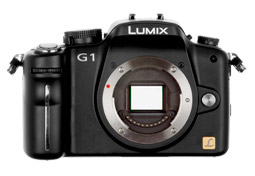Panasonic’s aim was to create the smallest body with a removable lens, and with the same image quality as the latest mainstream DSLRs. With an overall DxOMark score of 55.1, the Panasonic DMC G1 by and large achieved its goal, even though its scores for Color Depth (21.1 bits [average for 10 low-end DSLRs = 22.1]), Dynamic Range (10.2 [average = 11.4]) and Low-Light ISO (463 [average = 631]) kept it from attaining a better overall DxOMark ranking.
The Panasonic G1’s new Micro Four Thirds system represents an imaging technology between those of compact and DSLR cameras. Unsurprisingly, its RAW image quality performance achieves a logical intermediate ranking between bridge and mainstream DSLRs.
As the name suggests, Micro Four Thirds camera bodies are smaller than conventional Four Thirds cameras because the lens mount is smaller and the tradition mirror and pentaprism has been replaced by an electronic viewfinder. Despite the difference in overall size, however, both conventional Four Thirds cameras and Micro Four Thirds cameras have the same image sensor size and specifications.
Key sensor characteristics
The Panasonic Lumix DMC G1 features a Micro 4:3 format sensor with 12 Mpix, and with a pixel pitch of 4.3 µm (a typical size for this type of sensor). Four Thirds sensors were developed by Panasonic and Olympus, and the dxomark database contains analyses for several such models.
ISO Latitude ranges from ISO 100 to ISO 3200, which is one “real” stop more than almost all other bodies with this type of sensor (see ISO Sensitivity below).
Key performance factors
Color Depth, Signal-to-Noise Ratio, and Dynamic Range are too low to provide good image quality in low-light conditions (Low-Light ISO value of 463, compared with an average of 631 for recent DSLRs). With respect to this camera’s general use, the Low-Light ISO value needs to be improved over the next generation or so.
As previously stated, all ISO Sensitivity values provided are “real” (that is, all ISO sensitivities are obtained by applying a gain, analog or digital, before RAW delivery). One interesting point is that the Panasonic G1’s RAW ISO Sensitivity is slightly higher than the manufacturer’s published “jpeg” ISO values, contrary to results published for most camera bodies (whose RAW ISO sensitivities are usually also enhanced through a digital gain during RAW conversion).
Results for the Panasonic DMC Lumix G1 (as for all bodies with this type of sensor) are fairly close to those for low-end DSLRs, which is encouraging sign for this new type of sensor.
Disclaimer: This dxomark review evaluates only the selected camera’s RAW sensor performance metrics (i.e., Color Depth, Dynamic Range, and Low-Light ISO), and should not be construed as a review of the camera’s overall performance, as it does not address such other important criteria as image signal processing, mechanical robustness, ease of use, flexibility, optics, value for money, etc. While RAW sensor performance is critically important, it is not the only factor that should be taken into consideration when choosing a digital camera.





DXOMARK encourages its readers to share comments on the articles. To read or post comments, Disqus cookies are required. Change your Cookies Preferences and read more about our Comment Policy.